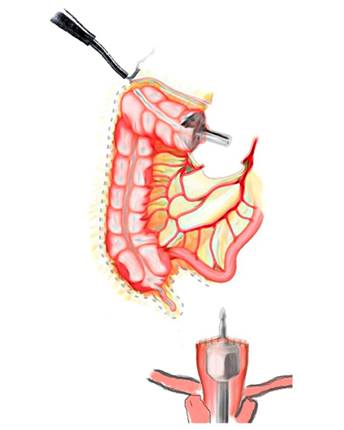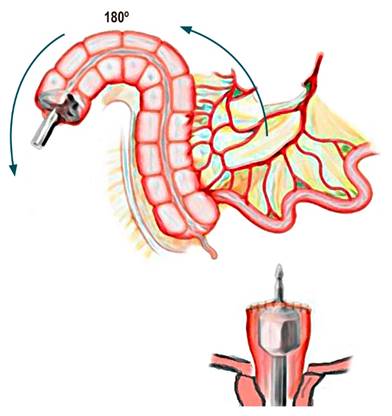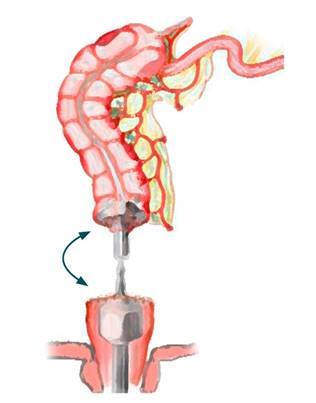Case report
Laparoscopic Deloyers Procedure as a Salvage Technique for Colorectal Anastomosis: An Alternative to Total Colectomy
1General Surgeon, Universidad del Valle, Hospital Universitario del Valle. Cali, Colombia.
2Coloproctologist Surgeon, Universidad del Valle, Fundación Clínica Valle de Lili. Professor, graduate course in General Surgery. Cali, Colombia.
Abstract
Introduction:
The Deloyers procedure is a valuable technique used in reconstructing bowel transit following an extended left colectomy, a Hartmann-type colostomy, or repeated colon resections. It enables the creation of a tension-free colorectal or coloanal anastomosis.
Case presentation:
A 60-year-old female patient presented for consultation regarding the closure of a colostomy. Her medical history included segmental colectomy of the sigmoid and descending colon, resulting in a Hartmann-type colostomy due to complicated diverticulitis. The patient underwent laparoscopic surgery, during which a segment of the transverse colon with a short mesocolon was identified. Due to the complete release of the colon, a colorectal anastomosis could not be performed. As an alternative to preserving the ileocecal valve and achieving a tension-free colorectal anastomosis, the patient underwent the Deloyers procedure.
Discussion:
The Deloyers procedure involves tension-free anastomosis between the right colon and the rectum or anus. It includes complete mobilization and a 180° counterclockwise rotation of the hepatic angle and the right colon. The right and middle colic vessels are divided, while preserving the ileocolic pedicle and the ileocecal valve, thus avoiding the need for total colectomy and ileorectal anastomosis, which may yield unsatisfactory functional outcomes.
Conclusion:
The Deloyers procedure represents a viable alternative to ileorectal or ileoanal anastomosis, offering satisfactory functional outcomes.
Keywords: Colectomy; surgical anastomosis; colostomy; ileocecal valve
Resumen
Introducción:
el procedimiento de Deloyers es una técnica útil en la reconstrucción del tránsito intestinal posterior a una colectomía izquierda ampliada, colostomía tipo Hartmann o resecciones colónicas iterativas, pues asegura una anastomosis colorrectal o coloanal sin tensión.
Presentación del caso:
una mujer de 60 años acudió a consulta para el cierre de una colostomía, con antecedente de colectomía segmentaria del sigmoides y colon descendente derivada con colostomía tipo Hartmann por diverticulitis complicada. Fue llevada a cirugía laparoscópica, en la que se encontró un segmento de colon transverso con meso corto y al liberarse completamente no se logró realizar la anastomosis colorrectal, por lo que se decidió realizar el procedimiento de Deloyers como alternativa para conservar la válvula ileocecal y obtener la anastomosis colorrectal libre de tensión.
Discusión:
el procedimiento de Deloyers consiste en la unión del colon derecho y recto o ano libre de tensión después de realizar la movilización completa y rotación de 180° en sentido antihorario del ángulo hepático y el colon derecho, en el que se seccionan los vasos cólicos derecho y medio, con preservación del pedículo ileocólico y la válvula ileocecal, para evitar la necesidad de una colectomía total y una anastomosis ileorrectal, para la cual los resultados funcionales pueden ser insatisfactorios.
Conclusión:
el procedimiento de Deloyers es una alternativa viable a la anastomosis ileorrectal o ileoanal con resultados funcionales satisfactorios.
Palabras clave: Colectomía; anastomosis quirúrgica; colostomía; válvula ileocecal
Introduction
The Deloyers procedure is a technique that consists of an anastomosis between the right or transverse colon and the rectum or anus after complete mobilization and rotation of the right colon, preserving the ileocolic vessels. It is advantageous in reconstructing intestinal transit after an extended left colectomy, Hartmann-type colostomy closure, or iterative colonic resections. In these situations, when the residual colon cannot reach the rectal stump without tension, the Deloyers procedure for tension-free colorectal or coloanal anastomosis can be used as an alternative technique to avoid total colectomy and ileorectal anastomosis1,2.
Case report
A 60-year-old woman attended the clinic for colostomy closure, a critical history in the medical record. Three years earlier, she underwent a segmental colectomy of the sigmoid and descending colon and was referred to with a Hartmann-type colostomy due to an episode of complicated diverticulitis. She had preoperative imaging studies; colon by rectal enema indicated a rectal stump inferior to the promontory, and proximal ostomy colonoscopy showed a segment of the transverse colon and normal right colon.
The patient was taken to laparoscopic surgery, where four disposable trocars were used, two of 12 mm and two of 5 mm, and a short segment of the descending colon with a short meso was found. When freed entirely, the colorectal anastomosis could not be performed. Therefore, we decided to perform the Deloyers procedure using a completely laparoscopic approach. With advanced bipolar energy, the transverse colon was released, including the hepatic and splenic angle and the right colon. The middle colic vessels were ligated proximally with Hem-O-Lok clips, preserving the ileocolic vessels through which the colonic remnant will receive irrigation from the marginal arteries. Once complete mobilization of the colon was achieved, a standard appendectomy was performed since the caecum and distal ileum were going to be located in the hepatic position, which in the future would have diagnostic difficulties in the acute event of appendicitis. Subsequently, counterclockwise rotation was performed around the axis of the ileocolic vessels of the right colon to conduct the tension-free colorectal anastomosis with circular mechanical suture number 29. She had a satisfactory clinical evolution during the hospital stay, for which she was discharged on the third postoperative day.
Discussion
The Deloyers procedure was first reported in 1964 by Dr. Lucien Deloyers. He performed complete mobilization of the right colon (Figure 1) and counterclockwise rotation around the axis of the ileocolic vessels, allowing colorectal or coloanal anastomosis with no tension and correct perfusion preservation3.
It is generally performed by open surgery, although the Deloyers laparoscopic procedure is feasible and safe but requires trained teams4. Indications for this procedure are generally tumors of the left colon (e.g., splenic flexure), synchronous colorectal cancers, rectal resections, ischemia of the left colon after inferior mesenteric artery ligation, Hirschprung’s disease, severe constipation, and reconstructions of complex intestinal transit, or iterative colonic resections when the anatomy is not favorable to allow a tension-free transversorectal or anal anastomosis1,5,6.
The procedure aims to achieve a tension-free anastomosis of the right colon and rectum or anus after complete mobilization and 180° anticlockwise rotation of the hepatic angle and the right colon (Figure 2). The right and middle colic vessels are sectioned, with preservation of the ileocolic pedicle and ileocecal valve, avoiding the need for total colectomy and ileorectal anastomosis, for which functional results may be unsatisfactory (Figure 3)1.
For the treating surgeon, it is vital to have a variety of surgical options to the conventional ones when reconstituting intestinal transit and to consider the Deloyers procedure as a safe technique and a possible alternative to ileorectal anastomoses when there is not enough remaining colon length to perform a traditional colorectal anastomosis after a resection.
Our patient’s procedure was performed using a completely laparoscopic approach, using advanced bipolar energy. The operating time was 3.5 hours. No intraoperative complications were recorded.
Conclusion
We deem the laparoscopic Deloyers procedure a safe and feasible technique and a viable alternative to the ileorectal or ileoanal anastomosis with satisfactory functional results.
Referencias
1. Manceau G, Karoui M, Breton S, Blanchet AS, Rousseau G, Savier E, et al. Right Colon to Rectal Anastomosis (Deloyers Procedure) as a Salvage Technique for Low Colorectal or Coloanal Anastomosis: Postoperative and Long-Term Outcomes. Dis Colon Rectum. 2012;55(3):363-8. https://doi.org/10.1097/DCR.0b013e3182423f83
[ Links ]
2. Sugarbaker PH. Progressive release of the left colon for a tension-free colorectal or coloanal anastomosis. Cancer Treat Res. 1996;82:255-61. https://doi.org/10.1007/978-1-4613-1247-5_16
[ Links ]
3. Deloyers L. Suspension of the right colon permits without exception preservation of the anal sphincter after extensive colectomy of the transverse and left colon (including rectum). Technic -indications- immediate and late results. Lyon Chir. 1964;60:404-13.
[ Links ]
4. Sciuto A, Grifasi C, Pirozzi F, Leon P, Pirozzi REM, Corcione F. Laparoscopic Deloyers procedure for tension-free anastomosis after extended left colectomy: technique and results. Tech Coloproctol. 2016;20(12):865-9. https://doi.org/10.1007/s10151-016-1562-z
[ Links ]
5. Martín Martín GP, Yang I, Zakaria A, Kim SH. Procedimiento laparoscópico de Deloyers para anastomosis sin tensión en la colectomía izquierda extendida [Internet]. aecirujanos.es. [consultado el 25 de junio de 2022]. Disponible en: Disponible en: https://www.aecirujanos.es/Procedimiento-laparoscopico-de-Deloyers-para-anastomosis-sin-tension-en-la-colectomia-izquierda-extendida_es_300_41_0_1_14.html#!
[ Links ]
6. Tang ST, Yang Y, Wang G Bin, Tong QS, Mao YZ, Wang Y, et al. Laparoscopic extensive colectomy with transanal Soave pull-through for intestinal neuronal dysplasia in 17 children. World J Pediatr. 2010;6(1):50-4. https://doi.org/10.1007/s12519-010-0006-5
[ Links ]














 texto en
texto en 



